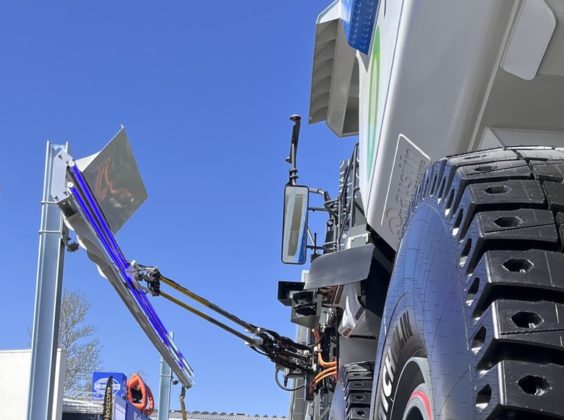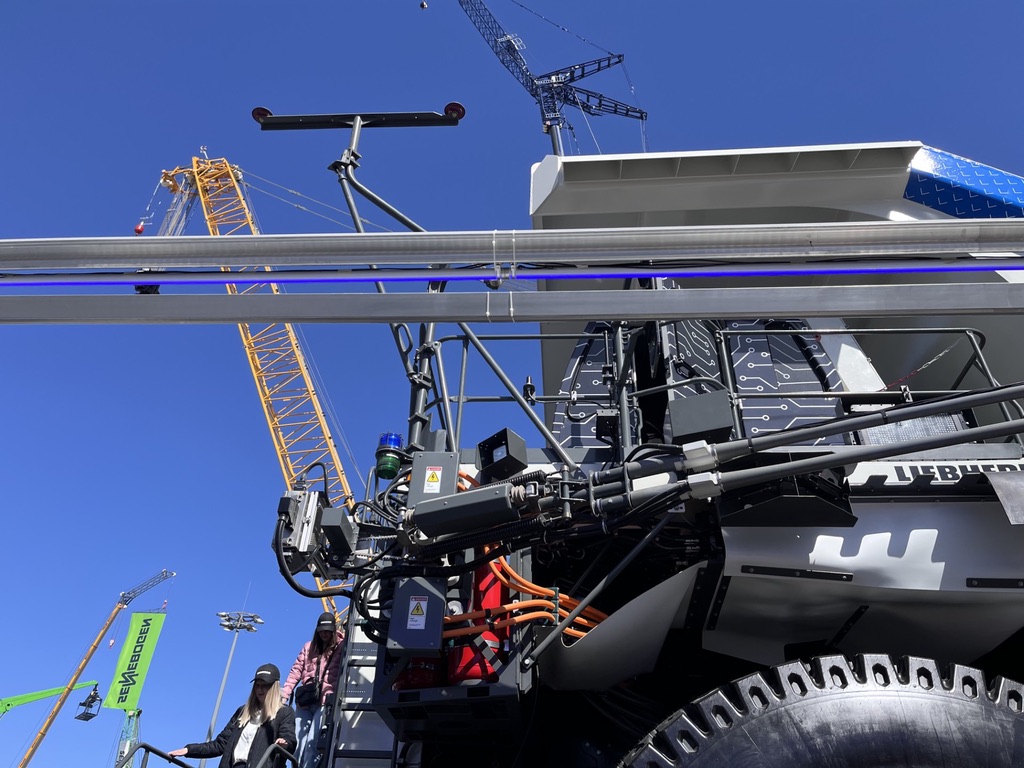Liebherr offers a wide array of products, technologies and services that can support customers’ decarbonisation journeys. One such solution is Liebherr Power Rail – a class-agnostic dynamic power transfer system that can be used with both battery-electric and diesel-electric Liebherr trucks.
IM saw the system up close on a Liebherr battery electric T 264 truck at bauma 2025 in Munich. It is based on Liebherr’s proven trolley bar technology and can work with its existing diesel-electric and battery-electric haulage solutions as well as alternative powertrain technology such as ammonia and fuel cell.
Traditional trolley technology supplies this power via an overhead catenary system supported by masts that stand up to 15 m tall. The trucks on site connect to the catenary system using either a pantograph or bar connection that then passes electricity through to the truck’s powertrain.

On the other hand, Liebherr Power Rail will have a current collector installed onto the side of the truck that extends out and connects with the system’s current conducting rail profile. The rail profile will be supported by precast concrete foundations and standard H-beam masts that stand 4.5 m tall – one-third of the height of those needed for traditional trolley.
The infrastructure that will be used for the Liebherr Power Rail concept is a ready-made solution from the rail industry Liebherr has harnessed for mining operations. “This is one of the factors that will make Liebherr Power Rail much faster and easier to install than traditional trolley. And while this part of the system is not unique, the current collector – which is currently in development – will be.”
Liebherr adds: “The current collector’s design is based on our proven trolley bar technology. In previous iterations, our trolley bar technology used two bars. For the Liebherr Power Rail’s current collector design, we combined the two bars into a single insulated trolley bar with carbon-based sliders that will act as the point of contact between the rail and the current collector. We are working with key industry partners for the design and supply of the current collector and our engineering teams are working to integrate this new technology into our range of mining trucks.”
The current collector will allow up to 2.6 m of lateral freedom. “We understand that no matter how well-kept haul roads on site are, obstacles can crop up. This lateral freedom will allow operators to avoid these obstacles while maintaining optimal levels of productivity. We can achieve this level of lateral movement because of the length of the current collector itself. The length will allow the current collector to rotate around the axis at the base of its fibreglass pole, meaning the system won’t be at risk of being pulled down. When trucks need to drive off of the haul roads to avoid obstacles, they’re more likely to ‘bounce’ over the rough terrain – like driving over loose gravel in a car. The torque at the base of the pole will capture the upward force from the truck’s vertical movements, preventing the impact from affecting the current collector.”
When trucks need to avoid obstacles that require more clearance than the lateral freedom will allow, the current collector can disconnect and reconnect as needed. The collector will be able to do this by using a similar system to our trolley bar connector. Funnels installed at strategic locations within the system’s infrastructure will guide the head of the current collector into the correct position to ensure a secure connection. The trucks will then be able to safely disconnect from the system at any point during the haul cycle with a simple flip of a switch – whether this is done manually by the operator in the cab or autonomously by one of Liebherr’s Assistance Systems.
Outside of reducing fuel consumption – and therefore greenhouse gas emissions – the biggest benefit of Liebherr Power Rail will be that it has fewer components than traditional trolley; fewer components that will be easier to install. “In fact, installing the masts will be quite similar to installing streetlamp posts. With fewer components, Liebherr Power Rail will be able to be installed in a fraction of the time needed to install a catenary system – which means you’ll be able to see the benefits of dynamic power transfer technology on your site much faster. Having fewer components also means that Liebherr Power Rail will be able to be more easily relocated to other locations on site. And with fewer components, Liebherr Power Rail will be a more economical option than traditional trolley.”
It adds that this system will also be far less intrusive on the haul roads than traditional trolley, adding to its ability to be easily installed or relocated on site. Rather than needing up to 5 m of clearance between a truck and traditional trolley system infrastructure, the masts and rail of Liebherr Power Rail will take up essentially the same amount of space as a berm.
Trucks running under Liebherr Power Rail will be able to travel at higher speeds than those not connected to a dynamic power transfer system – even when hauling a full payload uphill – which will increase the productivity of haulage fleets. However, reaching these speeds will depend on how the system is to be used. Things like the inclination of the haul road and whether the system is used for charging or propulsion will impact the speeds that vehicles can reach while connected to Liebherr Power Rail.
To further optimise productivity, Liebherr Power Rail will be compatible with Liebherr’s Trolley Navigation Assist system. This is a semi-autonomous system that extends and retracts the current collector so trucks are connected to Liebherr Power Rail for the longest possible time, helping users to get the maximum benefit out of the dynamic power transfer. “Our Assistance Systems will ensure a constant connection between the current collector and the rail. This connection will help to minimise stress on operators by automating the connection and disconnection process, while preventing damage to the truck and to the Liebherr Power Rail system as a whole.”
The current collector will provide 2.6 m of lateral freedom, which means operators can avoid obstacles on haul roads while staying connected to the system’s current conducting rail profile.
On top of all of this, the sliders on the current collector will be able to be easily changed from ground level without needing the specialised scaffolding or lifts required when working on pantographs in traditional trolley. The current collectors will have a ‘maintenance mode’ built into their logic that moves the sliders to an ergonomic height so they can be quickly changed out. This will help to minimise downtime by reducing the amount time needed to remove or service these components – which will come in handy as the sliders will be the highest wear item in the entire system as they will be in constant contact with the electrified rail.











